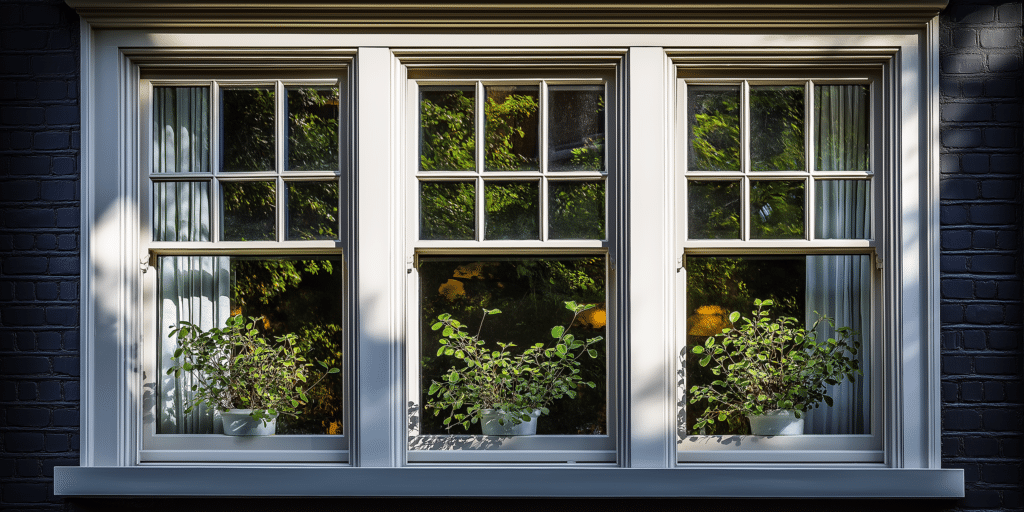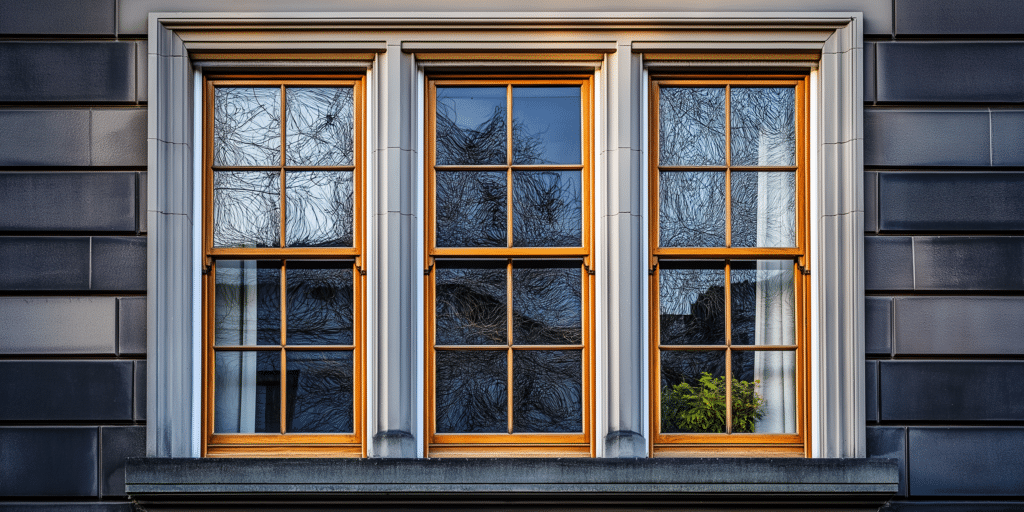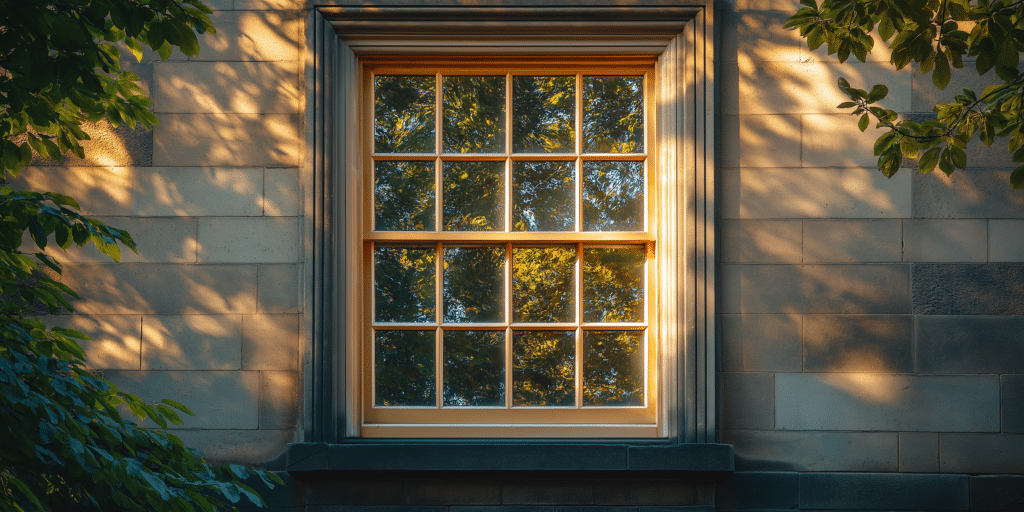Introduction to Sash Window Balance Adjustment

Sash windows are quintessential in British homes, particularly in period properties. Their elegance and functionality enhance the aesthetic and practical value of the home. However, over time, the balance system in these windows can become misaligned or wear down, leading to operational issues such as difficulty opening or closing.
Sash window balance adjustment refers to correcting the weights and pulleys that enable the smooth vertical movement of the window sashes. Sash windows may fail to stay open or closed without proper balance, reducing their energy efficiency and overall performance.
By understanding the importance of balance adjustments and recognising the signs of wear, homeowners can ensure their sash windows remain functional, energy-efficient, and secure. Improperly weighted sashes can cause significant wear over time. For instance, in historical homes, heavier window sashes can cause cords to fray, necessitating timely adjustments to avoid potential damage to the window frames.
Signs Your Sash Window Needs Balance Adjustment
Over time, sash window components—such as sash cords, pulleys, and weights—may deteriorate or become misaligned. Recognising the early symptoms of balance issues can help homeowners address the problem before it leads to further damage or inefficiency.
- Difficult operation: Is your sash window stiff or jammed, making it hard to lift or lower? This could indicate worn or damaged sash cords or a misaligned pulley system.
- Window not staying open: This indicates that the balance weights are no longer properly aligned. Modern spiral balances help prevent this issue, but even these may wear down after 20 years.
- Unusual noises: These noises often indicate that the pulley system is under stress, requiring lubrication or repair.
- Visible wear: Visible signs of wear mean immediate attention is required to prevent further deterioration.
Checking for these signs annually or whenever you notice operational issues can help maintain the integrity of your sash windows. These issues can escalate if left unaddressed, potentially requiring full replacement rather than simple adjustments. Small adjustments made early on can prevent costly frame repairs that often accompany prolonged neglect of sash window maintenance.
Why Sash Window Balance Adjustment Improves Efficiency
Many people overlook the role of sash window balance adjustment in home efficiency. Beyond ensuring the smooth operation of your windows, balance adjustment can also improve energy efficiency, security, and the lifespan of your sash windows.
- Energy efficiency: Well-balanced sash windows create a tight seal, preventing cold draughts in winter and reducing heat loss, lowering energy consumption. Improperly balanced windows allow air to escape, increasing energy bills as heating systems work harder to maintain indoor temperatures.
- Enhanced security: A sash window that doesn’t close properly due to misaligned balances can leave your home vulnerable to break-ins. If the window doesn’t close fully, the locking mechanism may not engage, reducing security. The risks of loose sashes include forced entry if the lock does not align correctly.
- Extended window lifespan: Adjusting the balance system ensures that your sash windows function as intended, reducing wear on other components such as pulleys and cords. Typically, sash windows should be inspected annually, but adjustments may be needed sooner if operational issues arise.
- Increased property value: Well-maintained sash windows, particularly in period homes, are considered an asset, adding both functional and aesthetic value to your property.
By keeping your windows properly balanced, you ensure smooth operation and improve the overall performance of your home’s thermal insulation and security. Correctly balanced windows can reduce heat loss by up to 25% during winter.
Step-by-Step Guide: How to Adjust Sash Window Balances

Adjusting sash window balances can be a manageable task for those who enjoy DIY home improvements. This guide provides a step-by-step approach to help you adjust the balance of your sash windows.
- Gather your tools: You’ll need a flathead screwdriver, replacement sash cord (preferably waxed cotton or nylon), balance weights, protective gloves, and a ladder. However, having the right materials, such as durable sash cords, is essential for a successful repair. Experts recommend sourcing high-quality materials to ensure durability.
- Remove the sash: Carefully unscrew the sash from the frame, ensuring it does not damage the window or the frame. Older windows can be more fragile, so extra care is needed when removing the sash, especially in historic homes with limited replacement parts.
- Examine and adjust the balance weights: Inspect the existing sash weights and pulley system. Adjust the weights by either repositioning or replacing them. Replacement weights can be ordered, but it’s essential to match the weight to the size of the sash for proper balance.
- Reinstall the sash: Once the balance system is adjusted, reinstall it, ensuring it moves freely up and down the frame. The sash should stay open without slipping and should close smoothly without excessive force.
Should I hire a professional for balance adjustments for homeowners with period properties? Yes, especially if the windows are original and you want to maintain their historical integrity. Improper DIY adjustments can cause further issues, especially in older or listed buildings.
Common Tools and Materials for Sash Window Balance Adjustment
The right equipment ensures a smoother process and reduces the risk of damaging delicate window components. Here’s a list of commonly used tools and materials:
- Sash cord: Opt for a high-quality waxed cotton or nylon sash cord, which is durable and flexible. If the cord is frayed, brittle, or snapped, it’s time for a replacement. Modern cords can last over 30 years if maintained properly.
- Balance weights: These counterweights keep the sash in place and enable smooth movement. Mismatched weights can cause the window to tilt or not stay open, so using the correct size and weight is crucial.
- Flathead screwdriver: A standard flathead screwdriver is used to remove the screws holding the sash in place. While a flathead is most common, a Phillips-head screwdriver may be needed depending on the window frame.
- Pulley system: The pulleys help the sash cord move smoothly, ensuring ease of operation. Pulleys should be lubricated regularly; however, if rusted, they may need to be replaced.
It’s always advisable to wear protective gloves when working with sash cords and pulleys to avoid injury, especially if the components are old or brittle. Use gloves specifically designed for handling vintage materials to prevent damage.
Professional vs DIY: When to Call an Expert for Sash Window Adjustments
While some homeowners may feel confident about adjusting their sash windows, there are instances where calling in a professional is the better option. But when should you attempt DIY sash window adjustment, and when is professional help required?
- Historic or delicate windows: If your home features historic sash windows, improper adjustment could damage the frame or sash. There is a significant risk of damaging the aesthetic or structural elements, particularly if the windows are original features.
- Lack of experience: Doing simple repairs is possible, but consulting a professional for complex issues is safer.
- Time constraints: A professional can often complete tasks more quickly and efficiently in cases where you’re uncertain about the repair or lack the time to do it properly.
- Complex repairs: A professional can ensure the job is done correctly if the sash balance requires extensive repair, such as replacing multiple weights or pulleys. Mistakes could lead to further damage, making professional intervention necessary and potentially more costly.
For period properties, hiring a professional who understands the nuances of historical window restoration is often advisable. Incorrect adjustments can damage the window frame structurally.
How Much Does Sash Window Balance Adjustment Cost?

When budgeting for home repairs, how much does sash window balance adjustment typically cost? The answer depends on whether you choose to do it yourself or hire a professional.
- DIY costs: For homeowners opting for DIY, sash cord and balance weights cost around £20-£50. DIY repairs can be cost-effective if done correctly, but only if no major issues arise. Choosing the right materials and tools upfront can prevent costly errors.
- Professional service: For those preferring expert assistance, a professional sash window balance adjustment can range between £150 and £250 per window, depending on the complexity of the repair and location. Additional charges may apply for more extensive repairs or if historic windows require specialist attention.
- Additional repairs: The cost can increase if additional repairs, such as pulley replacements or window frame adjustments, are required. During the adjustment process, other wear-and-tear issues may become evident. As per Sash Window Specialists, it’s not uncommon for frame repairs or glazing issues to surface during an adjustment.
- Historic windows: The cost of adjusting sash windows in listed or historic properties may be higher due to the specialised materials and techniques required. Maintaining the historical integrity of the windows is essential for preserving property value.
While DIY can save on costs, professional adjustment ensures accuracy, particularly for heritage properties where damage could devalue the home.
Sash Window Balance Adjustment and Energy Efficiency
Proper sash window balance adjustment affects not only the window’s functionality but also its energy efficiency. Poorly balanced windows can lead to draughts, higher energy bills, and reduced home comfort.
- Preventing draughts: A well-balanced sash window closes properly, reducing cold air infiltration. According to the Energy Saving Trust, proper draught-proofing can save up to £60 a year on heating bills.
- Lower energy bills: Sash windows that seal tightly due to proper balance adjustments help reduce energy consumption. Properly balanced windows create a noticeable improvement in indoor temperature control, particularly during the colder months.
- Maintaining indoor temperature: Proper balance adjustment ensures windows close tightly, preventing heat loss and improving home comfort. Older single-glazed sash windows often benefit the most from balance adjustments, especially if draught-proofing measures are applied simultaneously.
- Environmental impact: Efficient windows reduce your home’s carbon footprint by minimising energy waste. By improving insulation, balanced windows help reduce the need for artificial heating and cooling, lowering the environmental impact.
Energy efficiency is often overlooked when adjusting sash window balances, but the impact on heating costs can be significant, especially in older properties.
Benefits of Regular Sash Window Maintenance
Ensuring your windows are properly maintained can prevent costly repairs and help preserve the home’s original character.
- Prevent costly repairs: Regular maintenance helps identify minor issues before they escalate. Sash windows should be inspected annually or whenever performance issues are noticed.
- Improved functionality: Well-maintained sash windows slide easily and stay in position when opened, providing better usability. Checking the balance system, lubricating pulleys, and ensuring the sash cords are in good condition should be top priorities.
- Preserve historic value: For period homes, regular maintenance of sash windows preserves the building’s historical authenticity and value. Failing to maintain original features, such as sash windows, can decrease a property’s market appeal.
- Prolong window lifespan: Regular care can extend the life of your sash windows for many years. With proper care, sash windows can last several decades, maintaining both function and aesthetics.
A well-maintained sash window can last over 100 years. Regular adjustments are key to preserving both their function and charm.
Sash Window Balance Adjustment in Older or Historic Homes

Older homes often feature original sash windows that require more delicate care. But how different is the process of adjusting sash windows in older homes compared to newer properties?
- Historical accuracy: Period homes often require adjustments or replacements, such as sash cords, to be consistent with the original materials. Maintaining historical accuracy is essential in listed properties to preserve their value. According to Historic England, using the wrong materials can affect the building’s heritage status.
- Preserving aesthetics: Adjustments must be made carefully to avoid damaging original frames or glazing, especially in Grade II listed buildings. Modern materials can clash with the original aesthetic, diminishing the property’s historical appeal.
- Hiring specialists: Adjusting sash window balances in older homes may require the expertise of craftsmen experienced in period restoration. Specialists ensure that repairs are sympathetic to the window’s historical integrity while improving functionality.
- Long-term preservation: Regular balance adjustments help maintain the functionality and value of historical windows, preserving their operational longevity. Proper maintenance and adjustments can significantly delay or prevent the need for full window replacement.
Using modern materials in heritage homes can detract from the property’s value and authenticity. A balance between function and tradition is essential.
Common Problems After Sash Window Balance Adjustment
There are several potential reasons for ongoing problems post-adjustment, and understanding them can help ensure a successful repair.
- Improper sash cord installation: If the sash cord is too loose or incorrectly installed, the window may still be difficult to open or close. Recheck the tension and installation of the cord; if the problem persists, it may need to be replaced.
- Balance weights not aligned: Misaligned weights can cause the window to tilt or operate unevenly. Adjust the balance weights to be evenly distributed to maintain proper window balance.
- Sticking windows: Friction between the sash and the window frame could indicate that the balance isn’t functioning correctly or that the sash needs lubrication. Lubricating the frame and pulley system can improve window movement.
- Pulleys not functioning smoothly: Worn or damaged pulleys can impede the window’s smooth operation, making it difficult to move the sash. Pulleys should be inspected regularly and replaced if they show signs of wear, such as rust or sticking.
Common post-adjustment issues typically result from improper alignment or wear in older components. Regular inspection of sash weights and cords can prevent recurring problems.
Final Thoughts: Maintaining Sash Window Performance
Maintaining the balance of your sash windows is essential to preserving their beauty and functionality. Regular balance adjustments will enhance performance, improve energy efficiency, and extend the lifespan of your windows. Whether you do it yourself or hire a professional, balance adjustment is critical to sash window care.
A well-balanced sash window can provide excellent service for decades, but regular care and professional intervention when needed are key to long-term preservation.




